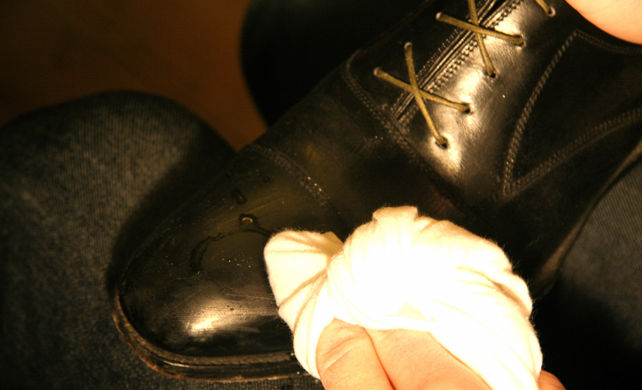[masterslider_pb id=”1″]

HOW TO CLEAN
- Most shoe labels, like Berluti and Church’s, will have in-house shoe cleaners and creams so always ask the boutique assistant for care tips and recommended products.
- First, take the laces off your shoes. Use a soft bristled brush to sweep off preliminary dirt and dust.
- Keeping your hand under the flap to keep the upper firm and flat, use your other hand to apply a suitable cleaner or saddle soap all over the leather parts of your shoe.
- Use the same brush to gently work the cleaner into the skin. Pay particular attention to any noticeable scuffs or marks.
- Let dry for about 20 minutes before proceeding to polish.
HOW TO POLISH & CONDITION
- Think of conditioning as moisturizer for your shoes, which will dry out over time. To prevent flaking and wrinkling, dab a dollop of conditioner on a soft cloth and rub gently all over in a circular motion.
- Choose a polish in a hue that matches your shoe. Experts generally recommend a lanoline-based beeswax polish, which will soften and protect at the same time.
- Wipe off excess polish with a soft clean cloth, and buff the shoe with—surprise!—a pair of panty hose for slick-as-a-dime shine. Well, nylon gets the job done, too.
HOW TO WEATHERPROOF
- A spray-on water repellent is an essential, fool-proof way to safeguard against the elements.
- Before application, use a warm sponge to prep your shoe. The gentle heat will increase the porosity of the skin, allowing for better absorption.
- Look for “breathable”, water-based repellents, which will allow excess moisture to dissipate for pliable, butter-smooth shoes.
HOW TO STORE
- A quality shoe tree is a worthwhile investment. Unfinished cedar is best, because it sponges up moisture and any disagreeable odors.
- Once you’re home, stuff your boot toe with butter paper, then string them up on the tree immediately.
- Regular use of a tree will maintain your shoe’s original shape, and will go miles towards preventing shrinkage and creases.
SOME FINAL TIPS
- If you’ve been polishing your shoes for awhile, there may be residual wax build-up. Use a specialized pre-cleaner before the cleaning process outlined above.
- It may be a no-brainer, but if you’ve just stepped out of a shower, make sure your feet are fully dry before slipping on your shoes.
- Use a good tortoiseshell shoe-horn to ease your foot in without creasing the back—a surefire recipe for shoe breakdown.
- Every few years, head back to the boutique or trusted cobbler to re-sole your shoes, which are like the tires of your car and require regular upkeep.
- Lay your shoes on their side to dry out, if you’ve been unlucky enough to have been battered on by a surprise rain shower on your way home.
Shoe trees: Shoe trees are crucial. They allow your recently worn shoes to contract and dry out to their ideal shape — but only if you choose the less decorative unvarnished ones. Varnished trees look posh, but they don’t properly draw moisture — i.e., sweat — out of the leather. Top marks go to unfinished cedar models with a split toe and a fully shaped heel: These ensure the closest possible fit between shoe and tree. Also, there’s no need to own a pair of trees for each pair of shoes. The vital time for using them is the hour or two after you have removed the shoes from your feet. After that, the shoes will have returned to their natural architecture and the trees can be removed.
Repair work: Invest as much care in choosing a cobbler to resole or reheel your shoes as you did in repurchasing them. And to prevent permanent damage (or, at least, the outrageous repair costs), have all work done before it’s absolutely necessary.
Suede: Suede shoes are in a category of their own, since you cannot polish away any scuff marks. Use a suede eraser (basically a brick of crumbly rubber) to rub away small blemishes. Then use a suede brush to restore the nap, or fuzz, of the leather.

Tips To Shoe Shining
Recommended Tools:
* A decent cloth from Lodger
* Turms Shoe brush (available from thebureaubelfast.com)
* John Lobb Leather conditioner
* Lodger Shoe bags for storage (they are made out of bamboo)
* Paul Smith coloured shoe trees
* J.M. Weston French polish
1. Prepare: Slip trees into the shoes as support for the pressure, wrap a damp cloth around your middle finger and forefinger and wipe your shoes down, brushing away any dirt and old polish with a damp cloth rub. With a smaller brush, remove any dirt from the welt of the shoe. If you want to apply a polish conditioner, now would be the time to do so, but ensure it is left to dry before you proceed.
2. Waterproof: With your cloth wrapped tightly around your fingers, dab them into the polish and with a rotating motion, massage the polish into the leather, focusing on the front and back on the shoe and damaged parts of the leather. Ensure all the leather is completely and evenly covered. Only use the weight of your fingers while doing so as not to damage the leather.
3. Polish: Using the same wrapped cloth, dampen the end with water and dab a little more polish on the end of your fingers. Continue to massage the shoe until a shine appears. You can do the same with a brush but the results will not be as magnificent. This buffing should take up to ten minutes per shoe for the best results. Some people say to use champagne instead of water, but my advice would be to keep it in the glass.
4.Finish: Leave to dry if possible, and pretend you don’t care when the compliments fly in.
Extra Tip: Re-use an old window cleaner bottle for water spray, and to find a decent wax, pop into any luxury shoe retailer. Try using a different polish colour to your shoes, for a unique shine (I tend to use blue on my browns).


